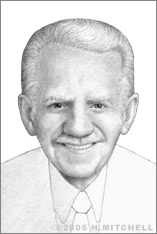Jheri Redding
Dry, tangled, hard-to-manage hair met its match in Jheri Redding, inventor of creme rinse, when he developed the first version of the concoction (now better known as “conditioner”) in the 1930s.
Redding, born Robert William Redding on March 2, 1907, in Rantoul, Illinois, grew up on a farm, the son of Irish immigrant parents. During the Great Depression, he became attracted to the beauty industry when he saw that farms were failing, but hairdressers and makeup artists appeared to be flourishing. He became a licensed cosmetologist, one of the first men ever to achieve this designation, and worked as a hairdresser where he began experimenting with chemicals and other ingredients to make his own shampoos and hairdressing solutions.
Redding was one of just a few people who believed that human beings’ hair was alive, not dead, and that its condition could be changed and improved with the right treatment. He began adding vitamins and minerals to the shampoos he created and selling them at his salon, marketing them furiously to patrons who slowly but surely began snapping them up.
During the mid-1950s, Redding, who was a hairstyling instructor and salon owner, decided to concentrate full-time on haircare products. He teamed with two partners to form his first products company, the Jheri Redding Products Company, in 1956. Redding was responsible for coming up with the products while his partners took care of the marketing and distribution, using Redding’s ideas for selling the products in salons, especially on slower days that typically fell early in the week.
Redding’s most famous breakthrough was a result of his unconventional thinking: Before it was known to be a fact, he believed that hair was made of protein, and as such he thought if treated with protein, it could be reconstructed and repaired when damaged. He created the Jheri Redding Crème Rinse Conditioner. The product revolutionized the haircare industry, as hairdressers and consumers began to realize that his conditioner actually worked. He was the first to conceive of this revolutionary idea.
By 1959, Redding was becoming distanced from his partners, so he left the company that year to join with actress Paula Kent to form a new company, Redken Laboratories. Redken was founded based on Kent’s idea to produce haircare solutions that would be less irritating to users’ skin and scalp. Kent and Redding began working to educate hairstylists as to the chemistry of hair and skin. They began with three products and built a large, successful enterprise. One of their keys to success was Redding’s introduction of the first-ever pH-balanced haircare products. He and the Redken company also received U.S. patent No. 6,015,574 for the exclusive, protein-based Interbond Conditioning System.
In 1969, Redding allowed Kent to buy him out and he moved on once more, writing a book on the “permanent wave” and then lecturing for a time for the National Health Federation. He had already formed yet another company, Jhirmack Enterprises, in 1968 to sell food supplements and vitamins, but he brought Jhirmack into the haircare fold in 1976, and began selling shampoos and conditioners that included nucleic acids for protein-building. The company prospered. Redding sold his stake in the company in 1978.
The following year, he and his son formed what would be Redding’s fourth company, Nexxus Products. Recognizing what he considered to be a “New Decade of Beauty,” Redding concentrated on developing the best, most advanced haircare products on the market, using fruits, herbs, plants and organic as well as synthetic polymers, he and his son raised the bar once more for high-end hairdressing solutions. The company quickly became a success, and Redding continued to work for Nexxus until his retirement in 1991.
Redding died March 15, 1998 at the age of 91 in Santa Barbara, California. He will be remembered for his many advances in the hair care industry, including his invention of the “Jheri curl,” a wavy hairstyle popular among Black people in the 1980s and 1990s.


